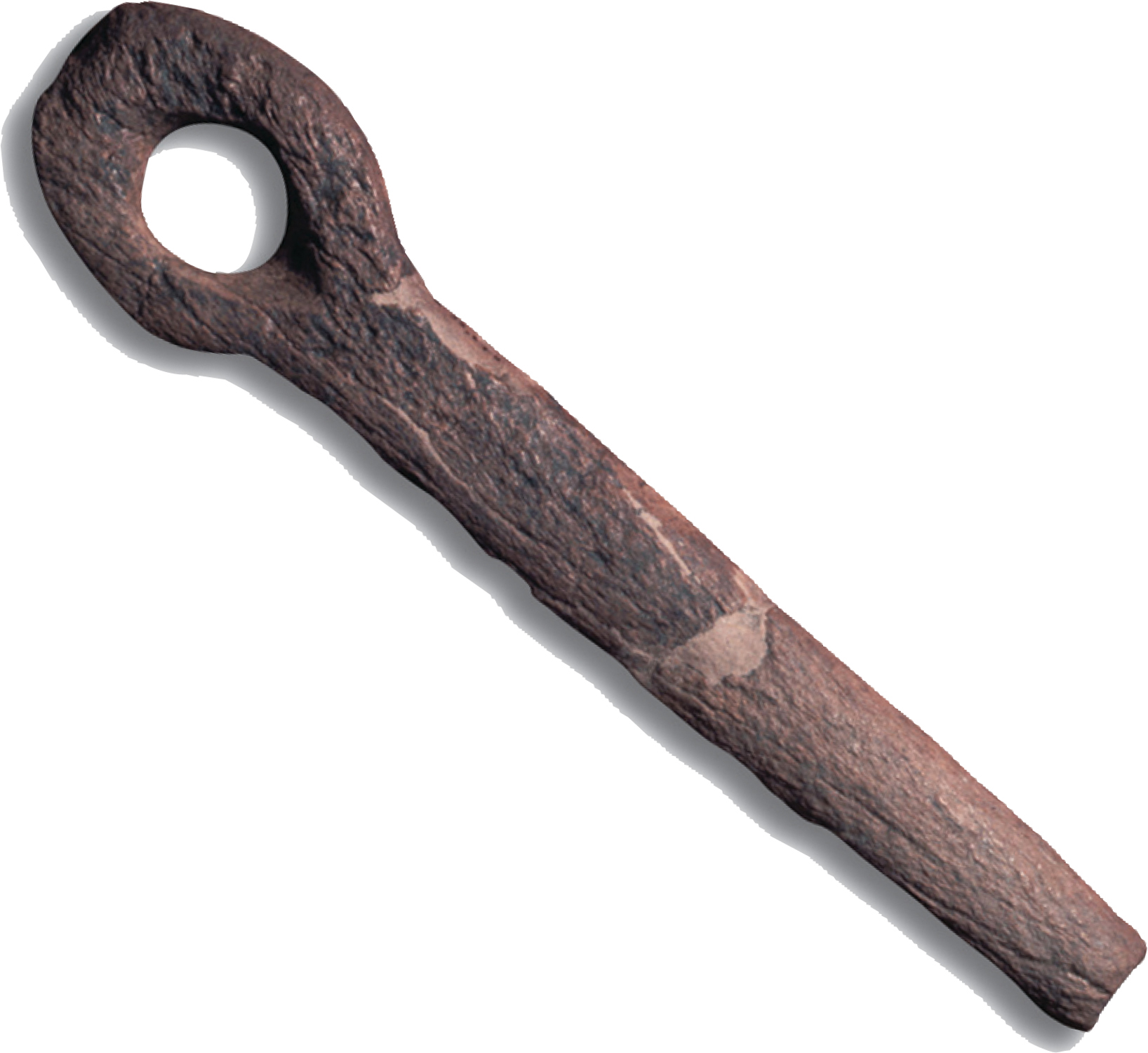The American Promise:
Printed Page 5
The American Promise Value
Edition: Printed Page 5
Chapter Chronology
Paleo-Indian Hunters

Clovis Spear Straightener Clovis hunters used this bone spear straightener about 11,000 BP at a campsite in Arizona, where archaeologists discovered it lying among the butchered remains of two mammoth carcasses and thirteen ancient bison. Clovis hunters stuck their spear shafts through the opening and then moved the spear straightener back and forth along the length of the spear shaft. Arizona State Museum, University of Arizona.
When humans first arrived in the Western Hemisphere, massive glaciers covered most of present-day Canada. Many archaeologists believe that Paleo-Indians probably migrated along an ice-free passageway on the eastern side of Canada’s Rocky Mountains in pursuit of game. Other Paleo-Indians may have traveled along the Pacific coast in small boats, hunting marine life and hopscotching from one desirable landing spot to another. At the southern edge of the glaciers, Paleo-Indians entered a hunters’ paradise teeming with wildlife that had never before confronted human predators armed with razor-sharp spears. The abundance of game presumably made hunting relatively easy. Ample food permitted the Paleo-Indian population to grow. Within a thousand years or so, Paleo-Indians had migrated throughout the Western Hemisphere.
Early Paleo-Indians used a distinctively shaped spearhead known as a Clovis point, named for the place in New Mexico where it was first excavated. Archaeologists’ discovery of abundant Clovis points throughout North and Central America in sites occupied between 13,500 BP and 13,000 BP provides evidence that these nomadic hunters shared a common ancestry and way of life. At a few isolated sites, archaeologists have found still-controversial evidence of pre-Clovis artifacts that suggest the people who used Clovis spear points may have been preceded by several hundred years by a few non-Clovis pioneers. Paleo-Indians hunted mammoths and bison, but they probably also killed smaller animals. Concentration on large animals, when possible, made sense because just one mammoth could supply meat for months. Some Paleo-Indians even refrigerated killed mammoths by filling their body cavities with stones and submerging the carcasses in icy lakes for later use. In addition to food, mammoths provided Paleo-Indians with hides and bones for clothing, shelter, tools, and much more.
About 11,000 BP, Paleo-Indians confronted a major crisis. The mammoths and other large mammals they hunted became extinct. The extinction was gradual, stretching over several hundred years. Scientists are not completely certain why it occurred, although environmental change probably contributed to it. About this time, the earth’s climate warmed, glaciers melted, and sea levels rose. Mammoths and other large mammals probably had difficulty adapting to the warmer climate. Many archaeologists also believe, however, that Paleo-Indians probably contributed to the extinctions in the Western Hemisphere by killing large animals more rapidly than the animals could reproduce. Some experts dispute this overkill interpretation, but similar environmental changes had occurred for millions of years before the arrival of Paleo-Indians without triggering the extinction of large animals—the presence of skilled hunters seems to have made a decisive difference. Whatever the causes, after the extinction of large mammals, Paleo-Indians literally inhabited a new world.
Paleo-Indians adapted to this drastic environmental change by making at least two important changes in their way of life. First, hunters began to prey more intensively on smaller animals. Second, Paleo-Indians devoted more energy to foraging—that is, to collecting wild plant foods such as roots, seeds, nuts, berries, and fruits. When Paleo-Indians made these changes, they replaced the apparent uniformity of the big-game-oriented Clovis culture with great cultural diversity adapted to the many natural environments throughout the hemisphere.
These post-Clovis adaptations to local environments resulted in the astounding variety of Native American cultures that existed when Europeans arrived in AD 1492. By then, more than three hundred major tribes and hundreds of lesser groups inhabited North America alone. Hundreds more lived in Central and South America. Hundreds of other ancient American cultures had disappeared or transformed as their people constantly adapted to environmental and other challenges.
REVIEW Why and how did Paleo-Indians adapt to environmental change?
